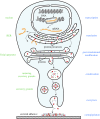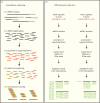Experimental strategies for the identification and characterization of adhesive proteins in animals: a review
- PMID: 25657842
- PMCID: PMC4275877
- DOI: 10.1098/rsfs.2014.0064
Experimental strategies for the identification and characterization of adhesive proteins in animals: a review
Abstract
Adhesive secretions occur in both aquatic and terrestrial animals, in which they perform diverse functions. Biological adhesives can therefore be remarkably complex and involve a large range of components with different functions and interactions. However, being mainly protein based, biological adhesives can be characterized by classical molecular methods. This review compiles experimental strategies that were successfully used to identify, characterize and obtain the full-length sequence of adhesive proteins from nine biological models: echinoderms, barnacles, tubeworms, mussels, sticklebacks, slugs, velvet worms, spiders and ticks. A brief description and practical examples are given for a variety of tools used to study adhesive molecules at different levels from genes to secreted proteins. In most studies, proteins, extracted from secreted materials or from adhesive organs, are analysed for the presence of post-translational modifications and submitted to peptide sequencing. The peptide sequences are then used directly for a BLAST search in genomic or transcriptomic databases, or to design degenerate primers to perform RT-PCR, both allowing the recovery of the sequence of the cDNA coding for the investigated protein. These sequences can then be used for functional validation and recombinant production. In recent years, the dual proteomic and transcriptomic approach has emerged as the best way leading to the identification of novel adhesive proteins and retrieval of their complete sequences.
Keywords: biological adhesion; metazoans; protein characterization.
Figures




Similar articles
-
Comparative Analysis of the Adhesive Proteins of the Adult Stalked Goose Barnacle Pollicipes pollicipes (Cirripedia: Pedunculata).Mar Biotechnol (NY). 2019 Feb;21(1):38-51. doi: 10.1007/s10126-018-9856-y. Epub 2018 Nov 10. Mar Biotechnol (NY). 2019. PMID: 30413912
-
[Analysis, identification and correction of some errors of model refseqs appeared in NCBI Human Gene Database by in silico cloning and experimental verification of novel human genes].Yi Chuan Xue Bao. 2004 May;31(5):431-43. Yi Chuan Xue Bao. 2004. PMID: 15478601 Chinese.
-
Echinoderm adhesive secretions: from experimental characterization to biotechnological applications.Prog Mol Subcell Biol. 2005;39:201-20. doi: 10.1007/3-540-27683-1_9. Prog Mol Subcell Biol. 2005. PMID: 17152699
-
Bioinspired Underwater Adhesives by Using the Supramolecular Toolbox.Adv Mater. 2018 May;30(19):e1704640. doi: 10.1002/adma.201704640. Epub 2018 Jan 22. Adv Mater. 2018. PMID: 29356146 Review.
-
Adhesive secretions in the Platyhelminthes.Adv Parasitol. 2001;48:101-224. doi: 10.1016/s0065-308x(01)48006-7. Adv Parasitol. 2001. PMID: 11013756 Review.
Cited by
-
Insights into the Synthesis, Secretion and Curing of Barnacle Cyprid Adhesive via Transcriptomic and Proteomic Analyses of the Cement Gland.Mar Drugs. 2020 Mar 31;18(4):186. doi: 10.3390/md18040186. Mar Drugs. 2020. PMID: 32244485 Free PMC article.
-
Fingerprinting of Proteins that Mediate Quagga Mussel Adhesion using a De Novo Assembled Foot Transcriptome.Sci Rep. 2019 Apr 19;9(1):6305. doi: 10.1038/s41598-019-41976-7. Sci Rep. 2019. PMID: 31004089 Free PMC article.
-
Structural and tribometric characterization of biomimetically inspired synthetic "insect adhesives".Beilstein J Nanotechnol. 2017 Jan 6;8:45-63. doi: 10.3762/bjnano.8.6. eCollection 2017. Beilstein J Nanotechnol. 2017. PMID: 28144564 Free PMC article.
-
Integrative Transcriptome and Proteome Analysis of the Tube Foot and Adhesive Secretions of the Sea Urchin Paracentrotus lividus.Int J Mol Sci. 2020 Jan 31;21(3):946. doi: 10.3390/ijms21030946. Int J Mol Sci. 2020. PMID: 32023883 Free PMC article.
-
Proteinaceous secretion of bioadhesive produced during crawling and settlement of Crassostrea gigas larvae.Sci Rep. 2018 Oct 17;8(1):15298. doi: 10.1038/s41598-018-33720-4. Sci Rep. 2018. PMID: 30333557 Free PMC article.
References
-
- Nachtigall W. 1974. Biological mechanisms of attachment: the comparative morphology and bionengineering of organs for linkage, suction, and adhesion. New York, NY: Springer.
-
- Waite JH. 1983. Adhesion in byssally attached bivalves. Biol. Rev. 58, 209–231. (10.1111/j.1469-185X.1983.tb00387.x) - DOI
-
- Smith AM, Callow JA. 2006. Biological adhesives. Berlin, Germany: Springer.
-
- von Byern J, Grunwald I. 2010. Biological adhesive systems: from nature to technical and medical application. Vienna, Austria: Springer.
Publication types
LinkOut - more resources
Full Text Sources
Other Literature Sources
Research Materials
Miscellaneous

